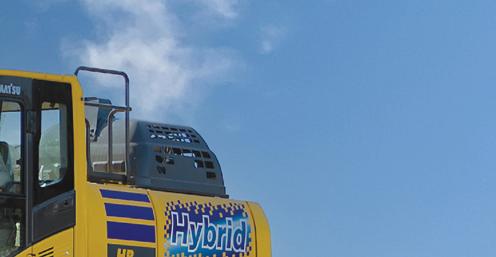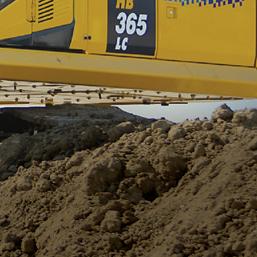

“The Nation’s Best Read Construction Newspaper… Founded in 1957.”



“The Nation’s Best Read Construction Newspaper… Founded in 1957.”

By Lori Tobias CEG CORRESPONDENT
Work on the largest rubble mound jetty in the world is coming to a close, ending 10 years of continuous jetty work in Clatsop County, Ore.
The South Jetty on the Columbia River, one of three jetties making up the river jetty system, is the last of the three to undergo critical repair work. The $172 million project got under way in 2019, following work on Jetty A and the North Jetty.
“Where are we with that now is we’re nearing completion of a six-year project,” said Colter Bennett, U.S. Army Corps of Engineers project engineer. “We’re in the final stretches of the final season. In terms of stone placement, I think we're a month away, but the site still needs major site restoration.”
The South Jetty was originally built starting in 1885 and has undergone repairs 10 times since then, Bennett said.
“This effort is the largest stone quantity that's been put on the jetty in a single project since the original construction.”
By the project’s end, the contractor, J.E. McAmis, of Chico, Calif., will install 450,000 tons of jetty armor stone.
“One way to think of it is that is about 34,000 Volkswagen Beetles,” Bennett said.
“As a result of the jetty’s size, the contractor had to go many different places to find the quantity of rock. The production rate of jetty armor stone is slow, so you have to go to multiple quarries that are producing armor stone at the same time — and producing fast enough — to finish the job on time. They had seven main contributing sources of stone, and all of these sources are in both Oregon and Washington.”









Helion, a Washington-based fusion energy company, announced on July 30, 2025, that it began work on the site of its first fusion power plant, Orion, marking a major step in bringing fusion electricity to the grid.
Located in Chelan County, Washington, the site was chosen for its ready access to transmission and legacy of energy innovation.
In 2023, Helion announced the world’s first power purchase agreement that will provide energy from the plant to Microsoft by 2028, with Constellation Energy serving as power marketer. With site work now under way, Helion remains on track to meet that goal.
“Today is an important day — not just for Helion, but for the entire fusion industry — as we unleash a new era of energy independence and industrial renewal,” said David Kirtley, Helion’s co-founder and CEO. “Since we founded the company, we have been completely focused on preparing fusion technology for commercialization and getting electrons on the grid. Starting site work brings us one step closer to that vision.”
Helion began building in Malaga, Wash., on land it is leasing from the Chelan County Public Utilities District.
Since 2023, Helion has actively engaged with local and state stakeholders — including government agencies, Tribal Nations and the public — in preparation for a siting and permitting decision. Helion will continue to work through the remaining steps in the permitting process to construct and operate a commercial fusion power plant on the site.
Helion’s approach of rapid iteration and testing has enabled the company to make steady progress toward a com-

mercial fusion machine.
Its seventh-generation prototype, Polaris, is expected to demonstrate the first electricity produced from fusion. With its previous prototype, Trenta, Helion was the first private company to achieve a fuel temperature of 100 million degrees Celsius, which is generally considered the required operating temperature for a commercial fusion power plant.
Helion arranged a purchase agreement with Microsoft to
provide 50 megawatts of power to the software company to power the data centers it is building in the valley, seattletimes.com reported.
The Chelan County Public Utilities District approved in June the leasing of 80 acres to Helion, according to wenatcheeworld.com. In its application, the company said it would build office, assembly and generator buildings on the site.
For details, visit helionenergy.com.
Oklo Inc., an advanced nuclear technology company, announced on July 15, 2025, that it selected Kiewit Nuclear Solutions Co. as the lead constructor for its first commercial Aurora powerhouse in Idaho, at Idaho National Laboratory (INL).
Under a newly executed Master Services Agreement, Kiewit Nuclear Solutions Co., a subsidiary of Kiewit Corp., will begin to support the design, procurement and construc-
tion of the Aurora-INL, with pre-construction expected in 2025 and commercial operations targeted for late 2027 to early 2028.
The Aurora-INL represents a milestone in Oklo’s near-term commercialization strategy to deliver energy using nuclear technology.
A project cost wasn’t disclosed.
Oklo selected Kiewit through a competitive process that evaluated both technical capabilities and construction expertise.
Because a significant portion of the Aurora powerhouse’s construction scope is nonnuclear, Oklo can leverage Kiewit’s extensive experience in delivering large-scale industrial and infrastructure projects.
This approach is designed to accelerate delivery timelines, reduce costs and uphold standards of safety and quality, underscoring Oklo’s commitment to the efficient, pragmatic deployment of advanced nuclear technology.

“We’ve completed key pre-construction milestones, including site characterization work in Idaho, in partnership with the U.S. Department of Energy and Idaho National Laboratory,” said Jacob DeWitte, co-founder and CEO of Oklo. “Kiewit brings the execution strength and project delivery experience that are essential as we move into this next phase. This is a critical step in helping us build efficiently and deliver clean energy on a meaningful timeline. Advanced
reactors will largely be able to be constructed differently than legacy plants, and a key pathway to realizing the economic benefits associated with that is to modernize how we design, procure, and build these plants.”
Oklo is positioned to deploy advanced nuclear technology in the near term, with a U.S. Department of Energy-approved site, secured fuel and demonstrated regulatory progress that support its ability to advance toward commercial operation.
“We’re excited to support Oklo in delivering one of the nation’s first commercial advanced nuclear projects,” said Mike Rinehart, president of Kiewit Nuclear Solutions Co. “As a leading design engineering, procurement and construction partner with decades of experience in complex energy infrastructure, Kiewit is well positioned to help bring Oklo’s innovative vision to life. This partnership reflects our shared commitment to advancing clean energy solutions through disciplined execution, safety and delivery certainty.”
The Aurora-INL is a key part of Oklo’s broader deployment pipeline, which includes agreements to supply more than 14 GW of clean energy to commercial customers and U.S. government partners.
For details, visit oklo.com.







Eco Material Technologies, a marketer of supplementary cementitious materials (SCMs) and producer of green cement products in North America, announced on July 29, 2025, the grand opening of its new Lakeview Plant in southern Oregon.
This milestone marks Eco Material’s first sustainably built manufacturing hub in the Pacific Northwest.
Strategically adjacent to Lake County's freight rail line, the Lakeview Plant is engineered to produce up to 300,000
tons per year of low-carbon cement replacements annually.
By replacing 25 to 100 percent of traditional portland cement in concrete mixes with Eco Material’s advanced SCMs and proprietary green cement blends, producers can reduce the carbon footprint of the cement portion of their concrete by up to 80 percent — the component responsible for the majority of embodied carbon dioxide in typical concrete formulations.
“The opening of the Lakeview Plant demonstrates our

commitment to sustainable innovation and marks a significant step forward in expanding access to domestically produced, low-carbon cement alternatives,” said Grant Quasha, CEO of Eco Material Technologies. “We’re thrilled to be able to serve the Pacific Northwest with economically competitive products that support infrastructure growth while reducing carbon emissions.”
The Lakeview facility is expected to create 30 permanent jobs, including skilled manufacturing roles and logistics positions in a historically underserved region. Approximately 75 percent of shipments will be distributed by rail using existing infrastructure.
“This facility represents more than just a new plant — it’s a powerful investment in Lake County’s future,” said Mark Albertson, Lake County commissioner. “By pairing advanced, low-carbon building materials with local job creation and infrastructure development, Eco Material Technologies is bringing both economic vitality and environmental responsibility to our community. We’re proud to welcome this transformative project while creating a great partnership to benefit all of Lake County.”
The facility rollout continues Eco Material's national expansion, including a recently opened terminal in Queens supplying 50,000 tons of harvested fly ash annually to the New York City metro market.
With the Lakeview Plant coming online, the company is on track to deliver more than 10 million tons of environmentally beneficial materials per year across 40 metro areas in North America.
(Photo courtesy of Eco Material Technologies.)
Construction will soon begin on a major expansion of one of Washington State University’s priority initiatives — the scientific and educational opportunities arising from the state’s only nuclear research reactor.
A new 5,000-sq.-ft. facility is being built at the Nuclear Science Center, where a 1megawatt reactor core has fueled research projects across disciplines, forged partnerships with government agencies and private companies and trained scores of reactor operators and nuclear scientists for 64 years. The new facility will house three “hot cells” for nuclear research, a chemistry wet lab, and other facilities.
“With the expansion, we’re now going to be able to use the full nuclear capacity of the core,” said Corey Hines, director of the center.
Kim Christen, WSU vice president of research, said, “These hot cells will supercharge the ability of WSU scientists and our regional and national partners to discover new kinds of fuels, produce specialized isotopes,and develop materials suited to extreme environments, like next-generation nuclear reactors.”
In addition to the new research it will enable, a key part of that capacity’s promise

is providing more students with the firsthand training that is a hallmark of the center, as the need grows to bolster the nation’s nuclear workforce.
Construction on the $7.6 million building, funded by a congressionally directed spending request supported by Sen. Patty Murray, is expected to take a year. But there are further phases to the project; it will take up to five years before the hot cells are in operation.
The reactor core represents a versatile resource. It is one of just four research nuclear reactors in the Pacific Northwest; it
is a TRIGA facility — Training, Research, Isotopes, General Atomics — that uses fuel especially suited for research. Through fission, it produces excess neutrons used to make radioisotopes and conduct experiments, with specializations in nuclear and radiochemistry, X-ray investigation and probing of materials, and nuclear materials research.
The core is operated from a control room, where student operators in training adjust the power of the reactor by raising and lowering materials that act as sponges to control the nuclear chain reaction.
At any given time, some 15 experiments are under way, as materials are irradiated and then studied. The experiments are conducted by researchers from across WSU, as well as government and private partners. The center also produces radioactive isotopes for use at U.S. national laboratories, for advanced nuclear and energy industry partners and medical research.
“These new capabilities will allow nuclear science research at WSU to move in directions that will benefit not just our state and region, but the nation as a whole,” Christen said.
A particular priority is national security work contributing to nuclear science, nuclear non-proliferation and emergency readiness exercises and training programs, Hines said.
“If you go to a big NFL game and there’s a high degree of safety, we know part of that safety is due to the work at the Nuclear Science Center and Washington State University,” Hines said.
Since the center’s establishment in 1961, 113 nuclear reactor operators trained there have been licensed by the U.S. Nuclear Regulatory Commission. Story by Shawn Vestal, Washington State University News & Media Relations


































































Most of the work on the jetty was completed with a Cat 6020 excavator outfitted with a customized front end, boom, stick, bucket and thumb specifically for jetty work, Bennett said.
“There are only two in the world outfitted that way, and one is in Coos Bay, and one is at the South Jetty.”
Combined, the three jetties total 9.7 mi. in length and are regularly pounded by waves 10 to 20 ft. high and more than 30 ft. during winter storms. Their purpose is to provide navigation through the channel of the Columbia River into the Pacific Ocean.
“There’s so much sediment that's coming out of our rivers into the ocean and, at that interface, at tends to fall out of suspension and that makes for shallow water,” Bennett said. “If you add jetties, they constrict the width valve where the river is discharging into the Pacific Ocean. That speeds the velocity of that water up and keeps the sediment in suspension ... instead of dumping the sediment right at the mouth where ships are trying to come and go. That's their main purpose ... to keep that channel deep and in the same exact spot.”
The South Jetty project was originally budgeted at $166 million but increased in cost by about $6 million.
“We had to add more rock to the contract,” Bennett said. “Also, we had to install a revetment


















to protect the haul route the trucks drive on to deliver the stone. That needed to be armored because the ocean was taking it away essentially.”
The number of jobs created by the project isn’t readily known.
However, Bennett noted that the project is not just a transaction between the government and contractor, but that the contractor relies on a “whole suite of subcontractors — mechanics, welders, stone suppliers, truckers, small parts, safety equipment. They have partnerships in many different industries. So, Astoria feels it in a big way. One of the main stone suppliers for both armor stone and also road material is Big River excavation out of the Astoria area. They rely on that contractor to produce a lot of the material for them and provide the trucking of equipment.
“So, the economics of these projects are huge. That money goes everywhere. The last figure I've heard and seen published is $31 billion worth of cargo annually moves through the mouth of the Columbia River. That provides a lot of the justification to spend this amount of money and make sure that the cities are in great shape all the time.”
The South Jetty project follows a one-year, $20 million repair project on Jetty A, completed in 2017 and a $39 million project on the North Jetty completed in 2020. CEG
(All photos courtesy of the US. Army Corps of Engineers.)





























































































Loved for the features. Trusted for the performance.
Hyundai wheel loaders have the power and performance, not to mention top-notch interiors, accurate onboard weighing system, industry proven drivetrain durability, clear sightlines, and handy tech that make life on the jobsite easier. So you can do more without feeling it. No wonder so many first-time Hyundai users become longtime fans.







































